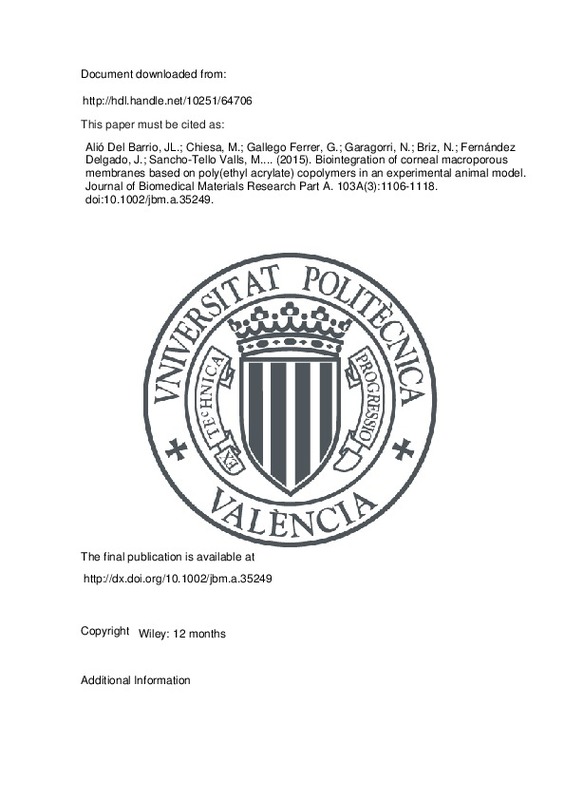JavaScript is disabled for your browser. Some features of this site may not work without it.
Buscar en RiuNet
Listar
Mi cuenta
Estadísticas
Ayuda RiuNet
Admin. UPV
Biointegration of corneal macroporous membranes based on poly(ethyl acrylate) copolymers in an experimental animal model
Mostrar el registro sencillo del ítem
Ficheros en el ítem
| dc.contributor.author | Alió del Barrio, Jorge L.
|
es_ES |
| dc.contributor.author | Chiesa, Massimo
|
es_ES |
| dc.contributor.author | Gallego-Ferrer, Gloria
|
es_ES |
| dc.contributor.author | Garagorri, Nerea
|
es_ES |
| dc.contributor.author | Briz, Nerea
|
es_ES |
| dc.contributor.author | Fernández Delgado, Jorge
|
es_ES |
| dc.contributor.author | Sancho-Tello Valls, María
|
es_ES |
| dc.contributor.author | Carda Botella, Carmen
|
es_ES |
| dc.contributor.author | García-Tuñón, Ignacio
|
es_ES |
| dc.contributor.author | Bataille, Laurent
|
es_ES |
| dc.contributor.author | Rodríguez, Alejandra
|
es_ES |
| dc.contributor.author | Arnalich Montiel, Francisco
|
es_ES |
| dc.contributor.author | Gómez Ribelles, José Luís
|
es_ES |
| dc.contributor.author | Antolinos Turpín, Carmen María
|
es_ES |
| dc.contributor.author | Gómez Tejedor, José Antonio
|
es_ES |
| dc.date.accessioned | 2016-05-25T13:43:01Z | |
| dc.date.available | 2016-05-25T13:43:01Z | |
| dc.date.issued | 2015-03 | |
| dc.identifier.issn | 1549-3296 | |
| dc.identifier.uri | http://hdl.handle.net/10251/64706 | |
| dc.description.abstract | Currently available keratoprosthesis models (nonbiological corneal substitutes) have a less than 75% graft survival rate at 2 years. We aimed at developing a model for keratoprosthesis based on the use of poly(ethyl acrylate) (PEA)-based copolymers, extracellular matrix-protein coating and colonization with adipose-derived mesenchymal stem cells. Human adipose tissue derived mesenchymal stem cells (h-ADASC) colonization efficiency of seven PEA-based copolymers in combination with four extracellular matrix coatings were evaluated in vitro. Then, macroporous membranes composed of the optimal PEA subtypes and coating proteins were implanted inside rabbit cornea. After a 3-month follow-up, the animals were euthanized, and the clinical and histological biointegration of the implanted material were assessed. h-ADASC adhered and survived when cultured in all PEA-based macroporous membranes. The addition of high hydrophilicity to PEA membranes decreased h-ADASC colonization in vitro. PEA-based copolymer containing 10% hydroxyethyl acrylate (PEA-HEA10) or 10% acrylic acid (PEA-AAc10) monomeric units showed the best cellular colonization rates. Collagen plus keratan sulfate-coated polymers demonstrated enhanced cellular colonization respect to fibronectin, collagen, or uncoated PEAs. In vivo implantation of membranes resulted in an extrusion rate of 72% for PEA, 50% for PEA-AAc10, but remarkably of 0% for PEA-HEA10. h-ADASC survival was demonstrated in all the membranes after 3 months follow-up. A slight reduction in the extrusion rate of h-ADASC colonized materials was observed. No significant differences between the groups with and without h-ADASC were detected respect to transparency or neovascularization. We propose PEA with low hydroxylation as a scaffold for the anchoring ring of future keratoprosthesis. | es_ES |
| dc.description.sponsorship | Contract grant sponsor: Fundacio Marato de TV3, Spain | en_EN |
| dc.language | Inglés | es_ES |
| dc.publisher | Wiley: 12 months | es_ES |
| dc.relation.ispartof | Journal of Biomedical Materials Research Part A | es_ES |
| dc.rights | Reserva de todos los derechos | es_ES |
| dc.subject | Poly(ethyl acrylate) | es_ES |
| dc.subject | Adipose derived stem cells | es_ES |
| dc.subject | Cornea | es_ES |
| dc.subject | Macroporous membranes | es_ES |
| dc.subject | Corneal scaffold | es_ES |
| dc.subject.classification | MAQUINAS Y MOTORES TERMICOS | es_ES |
| dc.subject.classification | FISICA APLICADA | es_ES |
| dc.title | Biointegration of corneal macroporous membranes based on poly(ethyl acrylate) copolymers in an experimental animal model | es_ES |
| dc.type | Artículo | es_ES |
| dc.identifier.doi | 10.1002/jbm.a.35249 | |
| dc.relation.projectID | info:eu-repo/grantAgreement/MICINN//CEN-20091021/ES/CUSTOMATIZED EYE CARE. OFTALMOLOGÍA PERSONALIZADA Y MÍNIMAMENTE INVASIVA/ | es_ES |
| dc.relation.projectID | info:eu-repo/grantAgreement/MITURCO//IAP-560610-2008-0044/ES/ELABORACIÓN DE MEMBRANAS AUTÓLOGAS PARA EL TRATAMIENTO DE PATOLOGÍAS CORNEALES/ | es_ES |
| dc.relation.projectID | info:eu-repo/grantAgreement/MICINN//SAF2010-19230/ES/MECANISMOS MOLECULARES INVOLUCRADOS EN LA REPROGRAMACON CELULAR DE LAS CELULAS GERMINALES PRIMORDIALES/ | es_ES |
| dc.rights.accessRights | Abierto | es_ES |
| dc.contributor.affiliation | Universitat Politècnica de València. Centro de Biomateriales e Ingeniería Tisular - Centre de Biomaterials i Enginyeria Tissular | es_ES |
| dc.contributor.affiliation | Universitat Politècnica de València. Departamento de Termodinámica Aplicada - Departament de Termodinàmica Aplicada | es_ES |
| dc.contributor.affiliation | Universitat Politècnica de València. Departamento de Física Aplicada - Departament de Física Aplicada | es_ES |
| dc.description.bibliographicCitation | Alió Del Barrio, JL.; Chiesa, M.; Gallego-Ferrer, G.; Garagorri, N.; Briz, N.; Fernández Delgado, J.; Sancho-Tello Valls, M.... (2015). Biointegration of corneal macroporous membranes based on poly(ethyl acrylate) copolymers in an experimental animal model. Journal of Biomedical Materials Research Part A. 103A(3):1106-1118. https://doi.org/10.1002/jbm.a.35249 | es_ES |
| dc.description.accrualMethod | S | es_ES |
| dc.relation.publisherversion | http://dx.doi.org/10.1002/jbm.a.35249 | es_ES |
| dc.description.upvformatpinicio | 1106 | es_ES |
| dc.description.upvformatpfin | 1118 | es_ES |
| dc.type.version | info:eu-repo/semantics/publishedVersion | es_ES |
| dc.description.volume | 103A | es_ES |
| dc.description.issue | 3 | es_ES |
| dc.relation.senia | 267327 | es_ES |
| dc.identifier.eissn | 1552-4965 | |
| dc.contributor.funder | Ministerio de Industria, Turismo y Comercio | es_ES |
| dc.contributor.funder | Fundació La Marató de TV3 | es_ES |







![[Cerrado]](/themes/UPV/images/candado.png)

